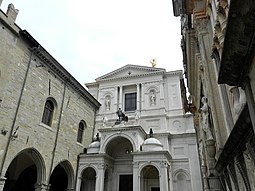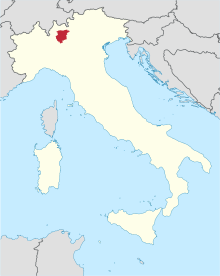Our website is made possible by displaying online advertisements to our visitors.
Please consider supporting us by disabling your ad blocker.
Roman Catholic Diocese of Bergamo
Diocese of Bergamo Dioecesis Bergomensis | |
|---|---|
 Bergamo Cathedral | |
| Location | |
| Country | Italy |
| Ecclesiastical province | Milan |
| Statistics | |
| Area | 4,243 km2 (1,638 sq mi) |
| Population - Total - Catholics | (as of 2020) 994,359 938,600 (est.) (94%) |
| Parishes | 389 |
| Information | |
| Denomination | Roman Catholic |
| Rite | Latin Rite |
| Established | 4th Century |
| Cathedral | Basilica Cattedrale di S. Alessandro in Colonna |
| Patron saint | St. Alexander |
| Secular priests | 667 (diocesan) 195 (Religious Orders) 11 Permanent Deacons |
| Current leadership | |
| Pope | Francis |
| Bishop | Francesco Beschi |
| Map | |
 | |
| Website | |
| diocesibg | |
The Diocese of Bergamo (Latin: Dioecesis Bergomensis; Italian: Diocesi di Bergamo; Lombard: Diocesi de Bergum) is a Latin diocese of the Catholic Church in Italy, and is a suffragan of the Archdiocese of Milan.[1][2] Geographically, Bergamo stood between the mainland interests of the Republic of Venice, and the territory of the Duchy of Milan. The duchy was regularly contested by the French and the Holy Roman Empire, which brought about repeated military operations. Internally, from the 12th to the 15th century, there was the usual party strife between the Guelphs, who generally supported the political and religious policies of the Papacy; and the Ghibellines, who generally supported the Emperors. As Kings of Italy, the emperors were feudal overlords of Lombardy.
The diocese was founded in the fourth century AD. Its first bishop was Narno, who was succeeded by Viator.
- ^ "Diocese of Bergamo" Catholic-Hierarchy.org. David M. Cheney. retrieved March 24, 2016
- ^ "Diocese of Bergamo" GCatholic.org. Gabriel Chow. Retrieved March 24, 2016
Previous Page Next Page


